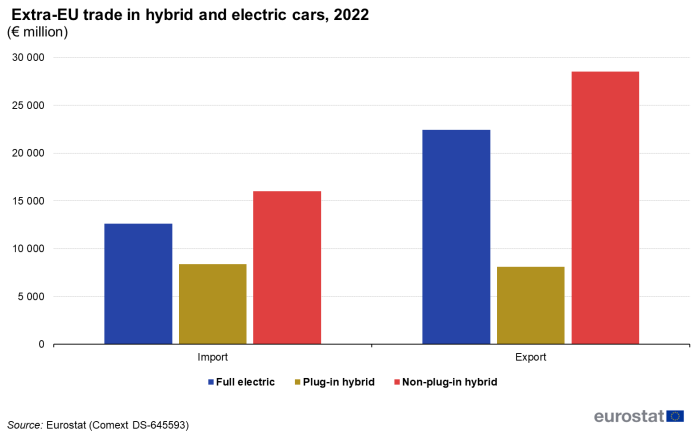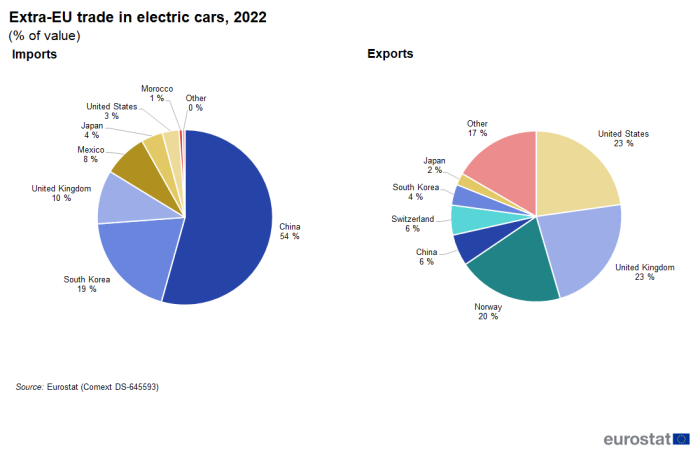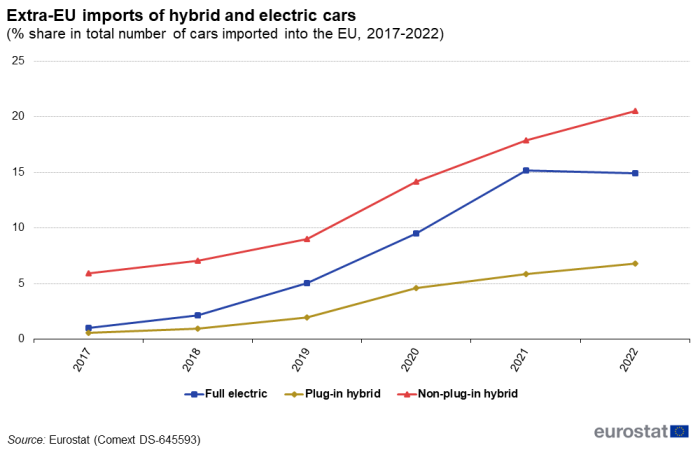International trade in hybrid and electric cars
Data extracted in October 2023
Planned article update: October 2024
Highlights
In 2022, the United Kingdom was the largest origin of extra-EU imports of non-plug-in hybrid cars, China for electric cars and the United States for plug-in hybrid cars.
In 2022, extra-EU imports of hybrid and electric cars made up 42% of all extra-EU imports of cars.
Extra-EU exports of full electric cars grew strongly in 2022.
Extra-EU trade in hybrid and electric cars, 2022
This article provides a picture of the international trade in hybrid (both plug-in and non-plug-in) and electric cars in the European Union (EU). It compares these three groups and shows developments over time of both extra-EU imports and exports. Finally, it shows the main partners for extra-EU imports and exports of each of these three products.
Full article
<sesection>
Between 2017 and 2022, the trade of electric and hybrid cars in the EU registered a staggering increase. In 2022, 42 % of the total number of cars imported were electric or hybrid, indicating an increase of 35 percentage points (pp) compared with 2017 (Figure 1). Non-plug-in hybrid cars went from 6 % of total car imports and 0.4 % of car exports in 2017 to 21 % and 13 %, respectively, in 2022. Full electric cars represented 15 % (+14 pp compared with 2017) of car imports and 9 % of exports (+8 pp) in 2022, plug-in hybrid cars represented 7 % (+6 pp) of car imports and 4 % of exports (+3 pp).
In 2022, the share of imports of non-plug-in hybrid cars in all cars was 21 % which was 6 pp more than for electric cars (15 %) while plug-in hybrids had a share of 7 % (Figure 1). Between 2021 and 2022, the share of electric cars dropped by 1 pp while the shares for plug-in hybrids and non-plug-in hybrids both increased. Combined electric and hybrid cars made up 42 % of all car imports.
The change in exports was also clear with a 24 pp increase in 2022 (26 % of the total number of cars exported) from 2017 (2 % of the total). In 2022, the share of exports of non-plug-in hybrid cars in all cars was 13 % which was 4 pp more than for electric cars (9 %) while plug-in hybrids had a share of 4 % (Figure 2). Between 2021 and 2022, the share of electric cars kept growing strongly while the shares for plug-in hybrids and non-plug-in hybrids did not increase much. Combined electric and hybrid cars made up 27 % of all car exports.
Overall, the EU exports more hybrid and electric cars than it imports
In 2022, the EU imported non-plug-in hybrid cars to the value of €16.0 billion, electric cars worth €12.6 billion and plug-in hybrid cars to the value of €8.4 billion (Figure 3). For all three categories of cars, the value for imports was less than the corresponding value for exports from the EU. Exports of non-plug-in hybrid cars were valued at €28.5 billion, electric cars at €22.4 billion and plug-in hybrid cars at €8.1 billion.

(€ million)
Source: Eurostat Comext DS-645593
Main partners for non-plug-in hybrid cars
The United Kingdom was the origin of 21 % of extra-EU imports of non-plug-in hybrid cars, followed by Japan (18 %) and Türkiye (15 %), the United States (14 %) and South Korea (13 %) as shown in Figure 4. The largest extra-EU export destination for non-plug-in hybrid cars was the United States (30 %), followed by the United Kingdom (16 %) and Norway (15 %).

(% of value)
Source: Eurostat Comext DS-645593
Main partners for electric cars
China (54 %) was largest origin of extra-EU imports of electric cars. South Korea (19 %) and the United Kingdom (10 %) also had double digit shares (Figure 5). The United States and United Kingdom (23 %) were the main destinations of extra-EU exports of electric cars, followed by Norway (20 %).

(% of value)
Source: Eurostat Comext DS-645593
Main partners for plug-in hybrid cars
The top-4 partners for extra-EU imports of plug-in hybrid cars all had double digit shares (Figure 6). The United States (40 %) had the largest share, followed by Japan (18 %), China (17 %) and the United Kingdom (11 %). The largest extra-EU export destination for plug-in hybrid cars was the United Kingdom (28 %), followed by China and the United States (both 18 %).

(% of value)
Source:Eurostat Comext DS-645593
Source data for tables and graphs
Data sources
EU data is taken from Eurostat's COMEXT database. COMEXT is the reference database for international trade in goods. It provides access not only to both recent and historical data from the EU Member States but also to statistics of a significant number of third countries. International trade aggregated and detailed statistics disseminated via the Eurostat website are compiled from COMEXT data according to a monthly process.
Data are collected by the competent national authorities of the Member States and compiled according to a harmonised methodology established by EU regulations before transmission to Eurostat. For extra-EU trade, the statistical information is mainly provided by the traders on the basis of customs declarations.
EU data are compiled according to Community guidelines and may, therefore, differ from national data published by the Member States. Statistics on extra-EU trade are calculated as the sum of trade of each of the 27 EU Member States with countries outside the EU. In other words, the EU is considered as a single trading entity and trade flows are measured into and out of the area, but not within it.
The EU data reflect the political change in the EU composition. Therefore, the United Kingdom was considered as an extra-EU partner country for the EU. However, the United Kingdom is still part of the internal market until the end of the transitory period (end 2022), meaning that data on trade with the United Kingdom for reference periods till, then were still based on statistical concepts applicable to trade between the EU Member States. As a consequence, while imports from any other extra-EU trade partner are grouped by country of origin, the United Kingdom data reflect country of consignment. In practice this means that the goods imported by the EU from the United Kingdom were physically transported from the United Kingdom but part of these goods could have been of other origin than the United Kingdom. For this reason data on trade with the United Kingdom are not fully comparable with data on trade with other extra-EU trade partners.
Methodology
According to the EU concepts and definitions, extra-EU trade statistics (trade between EU Member States and non-EU countries) do not record exchanges involving goods in transit, placed in a customs warehouse or given temporary admission (for trade fairs, temporary exhibitions, tests, etc.). This is known as ‘special trade’. The partner is the country of final destination of the goods for exports and the country of origin for imports.
Unit of measure
Trade values are expressed in millions or billions (109) of euros. They correspond to the statistical value, i.e. to the amount which would be invoiced in the event of sale or purchase at the national border of the reporting country. It is called a FOB value (free on board) for exports and a CIF value (cost, insurance, freight) for imports.
Product codes
The product codes used for the three products shown in this article are:
- Full electric: 87038010, 87038090
- Plug-in hybrid: 87036010, 87036090, 87037000
- Non-plug-in hybrid: 87034010, 87034090, 87035000
These codes only concern passenger cars. Buses and vans are not included.
Context
Trade is an important indicator of Europe’s prosperity and place in the world. The bloc is deeply integrated into global markets both for the products it sources and the exports it sells. The EU trade policy is an important element of the external dimension of the ‘Europe 2022 strategy for smart, sustainable and inclusive growth’ and is one of the main pillars of the EU’s relations with the rest of the world.
Because the 27 EU Member States share a single market and a single external border, they also have a single trade policy. EU Member States speak and negotiate collectively, both in the World Trade Organisation, where the rules of international trade are agreed and enforced, and with individual trading partners. This common policy enables them to speak with one voice in trade negotiations, maximising their impact in such negotiations. This is even more important in a globalised world in which economies tend to cluster together in regional groups.
The openness of the EU’s trade regime has meant that the EU is the biggest player on the global trading scene and remains a good region to do business with. Thanks to the ease of modern transport and communications, it is now easier to produce, buy and sell goods around the world which gives European companies of every size the potential to trade outside Europe.
Direct access to

